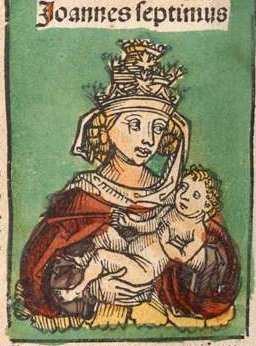Henslowe writes: R at poope Jone the 1 of marche 1591 ... xvs
In modern English: Received at Pope Joan, 1st March 1592 ... 15 shillings
Today, Lord Strange's Men performed a play called Pope Joan. It did not take much at the box office and this is the only record of its performance, so it was probably an old play at the end of its stage life. The play has not survived the passage of time, which is unfortunate, because it would be fascinating to see how an Elizabethan playwright approached the tale of Pope Joan.
In the Pope Joan legend, a 9th century Englishwoman disguises herself as a man in order to conceal her romantic relationship with a monk. In Athens, she becomes known for her great learning, and after her lover dies, she continues in her disguise to Rome, where she is eventually elected Pope. But she has an affair and becomes pregnant. She conceals the pregnancy but is unmasked when she gives birth during a religious procession. Depending on the legend, she either dies in childbirth or is stoned to death by the horrified crowd. The church hastily excommunicates her, buries her in unconsecrated ground, and tries to remove her name from the historical record.
 |
| Pope Joan gives birth in public (from a 1539 edition of Boccaccio's On Famous Women) |
The story is well-known and is still told today; for example here's a trailer for a 2009 German film:
This trailer captures the dramatic potential of the tale for modern audiences, but it's unlikely that an Elizabethan play would have been so sympathetic toward Joan. Craig M. Rustici's research shows that she was always represented in a negative light in Renaissance England, and he speculates that the play would have presented her as a "corrupt villainess", perhaps counselled by demons. Joan's tale was often utilised by anti-Catholic writers to undermine faith in the wisdom of the church and in the unbroken line of Papal succession; the play may, then, have been performed as a satire on the Catholic church, although Rustici adds that its depiction of a woman in a position of power could also have been covert satire on Queen Elizabeth I.
 |
| Pope Joan illustrated in the Nuremberg Chronicle (1493) |
FURTHER READING
Pope Joan information
- Craig M. Rustici, The Afterlife of Pope Joan: Deploying the Popess Legend in Early Modern England (University of Michigan Press, 2006), ch. 2.
- Martin Wiggins, British Drama, 1533-1642: A Catalogue, vol. 3 (Oxford University Press, 2013), entry 894.
- Sally-Beth MacLean and Lawrence Manley, Lord Strange's Men and their Plays (Yale University Press, 2014), 144-7.
Henslowe links
- Transcript of this page of the Diary (from W.W. Greg's 1904 edition)
- Facsimile of this page of the Diary (from the Henslowe-Alleyn Digitisation Project)
Comments?
Did I make a mistake? Do you have a question? Have you anything to add? Please post a comment below!
There was a Pope Joan play somewhere in the Cambridge UL Rare Books Room in the mid-90s (I read it there). Was it a later one?
ReplyDeleteProbably, but find it and make sure!!!
Delete